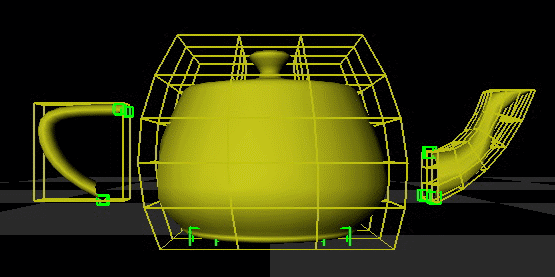

One such object is the famous Newell teapot which is shown above disassembled into three parts. The main pot is embedded in an FFD with the same topology as the one we used for the knight; this is primarily for the convenience of being able to keep the model on the surface of the floor with only 4 constraint points. The domain of the FFD was also slightly warped around the shape of the pot. The spout is also embedded in an FFD which is quadratic along its length and linear in the cross-sectional directions. It too was embedded into a warped domain. Finally the handle is subject to an affine transformation.
 Teapot Assembly (Mpeg-1 movie, 336912 Bytes).
Teapot Assembly (Mpeg-1 movie, 336912 Bytes).
For the assembly animation point constraints were applied to thee points on the handle and three points on the spout. These points were then moved from the positions shown above to their final locations inside the main pot. Once the spout and handle are in place, these point constraints are replaced by attachment constraints which keep the spout and handle fixed to the pot. To show that they are attached we give a little tug on the handle and spout. The tugs are animated by once again using point constraints. This example ends with the teapot sighing (sorry no sound). The sighing motion was specified by animating the reference values for the shape preserving potential functions.
 Walking Teapot (Mpeg-1 movie, 395268 Bytes).
Walking Teapot (Mpeg-1 movie, 395268 Bytes).
For the walking animation, there are again four constrained points on the base of the pot which we used to move the teapot in a walking motion. As in the previous example the handle and spout are held in place using attachment constraints. The attachment constraints are equivalent to a motion hierarchy in a conventional animation system in that the transformation of one object affects another. In this case the motion induced by the animating the constrained points on the pot for the walking motion is transferred to the spout and handle.
This walking animation produced even more interesting results than the walking knight. Altogether this system has 84 DOF's with 30 constraints. The greater number of DOF's in the system for this example produced a richer set of secondary motion effects. Not only did the pot respond to the animation of the walking motion of the control points, but the spout and handle did as well. The simulation time for this animation was approximately 3.5 seconds per frame, reflecting the greater complexity of the system. The computation was performed on a Silicon Graphics Indigo2 workstation with a 150Mhz. R4400 CPU.
The original model of the teapot was created by Martin Newell and is in the public domain. It was taken from an Inventor data file distributed with Silicon Graphics computer systems.
Back to: Examples | Rudy's Home Page